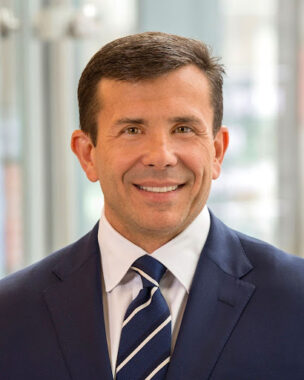Launch of new Pompe treatment ‘exciting,’ Amicus chairman says
Combination of Pombiliti plus Opfolda is third approved treatment for LOPD

The Crowley family (photo courtesy of Amicus Therapeutics).
Bringing a third medication for late-onset Pompe disease (LOPD) to the treatment table is a personal triumph for Amicus Therapeutics executive chairman John Crowley.
Pursuit of this new treatment for LOPD, while working to find a hoped-for cure, began just more than 25 years ago when Crowley’s children were diagnosed with Pompe. Megan, now 26, was diagnosed at 15 months, and Patrick, now 25, was diagnosed as a newborn.
Crowley left a career in finance, moved to the pharmaceutical world, and eventually founded Amicus Therapeutics nearly 19 years ago. His goal was to support the search for medical treatments while being compassionate and hopeful for those living with rare diseases.
Amicus Therapeutics’ combination therapy Pombiliti (cipaglucosidase alfa) plus Opfolda (miglustat) was approved by the U.S. Food and Drug Administration (FDA) in September. It treats certain adults with LOPD who are not improving on their current enzyme replacement therapy (ERT).
Lumizyme (alglucosidase alfa) was the first medication for Pompe; it was approved by the FDA in 2010. It was not until 11 years later that a second therapy — Nexviazyme (avalglucosidase alfa)— came to market. Crowley is thrilled that Amicus’ combination therapy became the third treatment option.

Amicus Therapeutics executive chairman John Crowley (photo courtesy of Amicus)
“Pompe is a unique example of a rare disease where there are now multiple treatment options and, to me, that’s incredibly exciting,” he said. “It’s another waypoint on the journey toward more effective treatment, and, hopefully, someday as well, a cure.”
Clinical trials for Pombiliti and Opfolda, formerly called AT-GAA, began in 2016, as Amicus sought to combine ERT with an enzyme stabilizer that helps the enzyme stay active for longer in the body, making it more effective than the ERT alone.
Miglustat is an oral therapy, whereas Pombiliti is given as an intravenous (into-the-vein) infusion.
“You want to create new ideas, new molecules, put them through comprehensive clinical studies to generate data so that patients and physicians can make informed choices on what medicine could be most appropriate for them in managing the course of their disease,” Crowley said. “And importantly, what you want to do is always to see incremental improvements in the treatment options as well.”
The Pombiliti and Opfolda combination has made a meaningful change in the treatment paradigm for people living with Pompe, according to Crowley. Amicus has more than 200 people around the world who are using the treatment. The company is working to expand its use for children — a pediatric study is underway — and also for people who have not yet received any medication for Pompe.
Crowley notes that the vast majority of the unmet needs today are people who are currently being treated but not noticing improvement. He adds, though, that the company is seeing people make improvements after switching to the Amicus therapy. The expectation is that more people will start to choose their combination of medications.
“The data is overwhelmingly convincing that for people who switch, they could not only become stable, they can improve,” he said. “If they could walk, they could walk farther now. If they’re in a wheelchair, they can see improvements in upper body strength and movement. If they’re breathing without a ventilator, they can breathe better. That’s exactly what we want.”
A long-standing commitment
The company has made a decades-long commitment to the Pompe patient community — it is estimated that one in every 40,000 people in the U.S. is affected by Pompe. And it has pledged to put a significant portion of its revenue from any approved medicine back into research and development.
“It fits with our ethos as a company,” Crowley said. “That’s where we ask everybody to think, ‘If you had this disease or you’re the mom or dad of a child with this disease, what would you do? What actions would you take?’”
Amicus eyes gene therapy as Pompe disease treatment
Looking ahead, Amicus is researching gene therapy for Pompe. The company’s plan is to go beyond using an adeno-associated virus (AAV) as the delivery method and instead is trying to solve the problem of targeted delivery and immunogenicity — the capacity to stimulate the body’s immune system to produce a protective response.
“We’re pretty convinced that AAV is not the right way to go,” he said. “In a disease where you have to get to all skeletal muscle, cardiac muscle, smooth muscle like the esophagus, the diaphragm, the therapeutic window for safety and efficacy is just too narrow.”
While Amicus has worked in collaboration with universities, at the moment it is focusing on in-house efforts. The company has about 500 employees, with corporate headquarters in Princeton, New Jersey, a Research and Gene Therapy Center of Excellence in Philadelphia, international headquarters in Marlow, England, and global offices in 10 other countries.
Amicus has medications available to more than 2,000 people in 40 countries around the globe, including Galafold (migalastat) for treating Fabry disease, a rare genetic disorder also caused by an enzyme deficiency. The company also has an experimental gene therapy for Batten disease, a group of rare, inherited neurological disorders, currently in Phase 1/2 clinical trials.
The progress is personal
There also is positive personal progress from Crowley’s fight to cure his children of the rare disease. His daughter, Megan, graduated from the University of Notre Dame in 2019 and then received her master’s degree in social work from the University of North Carolina at Chapel Hill in 2021. She now works at the Make-A-Wish Foundation.
His son, Patrick, works in Princeton, New Jersey, in a flower store run by an organization called Community Options, “making big, beautiful flower arrangements.”
“They’re my reason behind all of my work,” Crowley said. “In building the company and starting the company almost 19 years ago, we chose the Latin word for friend. We wanted to be the most patient-focused, patient-friendly company in all of biotechnology, and I think we’ve made great strides toward that vision.”






